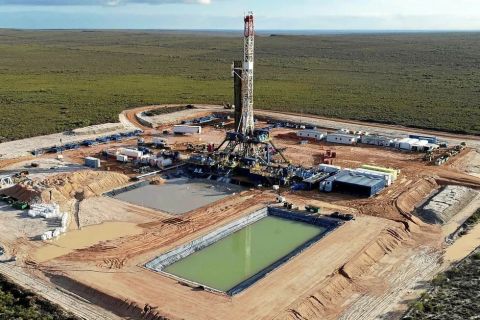Regulations aimed at ensuring tens of thousands of inactive oil and gas wells dotting the Alberta landscape are properly reclaimed could be a death knell for some producers already crippled by weak energy prices.
The Alberta Energy Regulator's (AER) updated Licensee Liability Rating (LLR) program came fully into force last August just as oil prices tumbled below $40 a barrel for the first time since 2009.
It is already being blamed for helping sink one producer and more could follow, according to industry insiders on April 6.
The "polluter pays" policy makes companies put down a deposit if their production revenues are deemed insufficient to cover the estimated cost of cleaning up their oil wells at the end of their producing life. That cost can range from roughly C$60,000 to over C$300,000 a site, depending on well depth, location and other factors.
While the policy is aimed at ensuring the broader energy industry and tax-payers are not left footing the bill, it has squeezed small firms, which typically have a higher proportion of tapped-out wells, to the point where some continue to operate loss-making assets just to avoid having to pay security deposits for inactive wells.
"It's devastating, it's the final thing that pulls the rug right out from all the weak companies. You're forced to produce wells that are uneconomic just to keep your LLR positive," said Tim Veenstra, an engineering consultant with privately-held Crimson Oil & Gas.
Calgary-based Crimson, together with Northpine Energy which it bought last year, produces just under 500 barrels a day from around 200 wells, Veenstra said, including several that are producing at a loss and 39 inactive wells.
The AER said it tries to help companies experiencing difficulties, but producers have to be able to clean up their own wells.
"It's the licensee's responsibility to ensure they're in a position to be able to care for their infrastructure throughout their entire lifecycle," an AER spokesman said.
Clean-Up Bill
A rise in bankruptcies makes it more likely that the sector could be left with the bill—the very problem the regulator was trying to avoid.
When companies are insolvent, their idle wells can end up in the province's orphan well association (OWA) program if no party is legally responsible for them. The association is funded by an annual levy on industry totaling C$30 million.
The number of wells in the OWA was 768 in March 2016, quadrupling from two years ago partly due to rising bankruptcies.
Consulting firm Deloitte has warned that a third of oil and gas producers could go bankrupt this year, prompting some observers to voice concerns the program may not have enough funds to cover the clean-up costs of the wells currently on the OWA's books.
"The problem is not getting solved. The OWA has such a backlog they cannot process wells as fast as they are coming in," said Wood Mackenzie analyst Paul Pasco, adding that the LLR system was exacerbating issues.
"Companies are unable to close or complete deals because of it. In the long-term, companies will be forced to go bankrupt and then their assets will defer to the OWA."
The OWA operates under the authority of the AER, and deferred a request for comment to the regulator. An AER spokesman said abandonment costs varied between wells and he could not speculate on the total cost.
As well as orphans, there are 79,000 inactive wells—defined as wells that have not produced for at least six months—in Alberta, 21,000 of which have been inactive for more than a decade.
Permanently closing just those 21,000 could cost up to C$6.3 billion, based on estimates from the Petroleum Services Association of Canada, which last month asked the federal government for C$500 million to help clean-up wells and support employment.
Out Of Options
The catch-22 scenario is leaving the smallest and most vulnerable oil and gas producers, running out of options.
The clean-up cost issue has already gummed-up asset sales in the province, as buyers are not keen to buy portfolios that come with large numbers of inactive assets, and the energy regulator has balked at letting companies carve out and sell good assets.
Last month Alberta-based Terra Energy ceased operations after its bank demanded full loan repayments.
Terra said efforts to sell assets in Alberta to pay down debt had been hampered by having a well liability rating below 1, the level at which liabilities outweigh assets and the AER can block asset sales.
Terra is one of 63 companies currently in AER's liability management plan, which essentially is a last-ditch effort at helping teetering companies with a liability rating close to, or below 1, by allowing them to make quarterly payments to cover security deposits.
Recommended Reading
Brett: Oil M&A Outlook is Strong, Even With Bifurcation in Valuations
2024-04-18 - Valuations across major basins are experiencing a very divergent bifurcation as value rushes back toward high-quality undeveloped properties.
Marketed: BKV Chelsea 214 Well Package in Marcellus Shale
2024-04-18 - BKV Chelsea has retained EnergyNet for the sale of a 214 non-operated well package in Bradford, Lycoming, Sullivan, Susquehanna, Tioga and Wyoming counties, Pennsylvania.
Triangle Energy, JV Set to Drill in North Perth Basin
2024-04-18 - The Booth-1 prospect is planned to be the first well in the joint venture’s —Triangle Energy, Strike Energy and New Zealand Oil and Gas — upcoming drilling campaign.
PGS, TGS Merger Clears Norwegian Authorities, UK Still Reviewing
2024-04-17 - Energy data companies PGS and TGS said their merger has received approval by Norwegian authorities and remains under review by the U.K. Competition Market Authority.
Energy Systems Group, PacificWest Solutions to Merge
2024-04-17 - Energy Systems Group and PacificWest Solutions are expanding their infrastructure and energy services offerings with the merger of the two companies.




